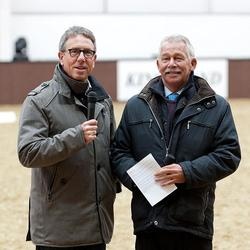
The value of judges learning through discussion was highlighted by two London 2012 Olympic judges, Holland’s Wim Ernes and Britain’s Stephen Clarke, who hosted the 2012 BDSC National Judges Convention, held at Bury Farm EC in Buckinghamshire.
Stephen and Wim awarded marks for a number of movements performed by the dozen guinea pigs including Richard Davison (Hiscox Aliano), Maria Eilberg (Woodlander Rockstar) and Becky Moody (Carinsio) during the day, which attracted an appreciative audience of more than 400.
Their marks occasionally varied slightly and triggered discussion. Each explained their thought process to describe how they arrived at their final mark.
Stephen said: “At the big competitions, this is exactly what we [the judges] do in the breaks. That is how we learn. The day that all judges give the same marks like robots will never come. I don’t mind if we have marks which are a little apart, if we have valid reasons for giving that mark."
Wim said: “It is important to explain what is good and bad about a movement. One part might be worth an eight, another a six, and you have to balance it out. I find that once you comment on it, then the mark finds you. If the movement had been performed satisfactorily, it has to be a minimum of six. If I describe something as ‘fairly good’, it earns a seven.”
The first half of the day was dedicated to judging young horses, including a three-year-old lunged by British Dressage Chairman Jennie Loriston-Clarke, Sweatheart (Lizzie Murray), DHI Bravo (Nathalie Kayal), Samba Dancer (Lucy Cartwright), El Zorro (Matt Hicks) as well as Carinsio.
“At these seminars, we so often discuss grand prix horses, but almost never talk about judging young horses the right way. As judges, we control the way the riders train their young horses; that is why it is so important to get it right,” said Wim, who is president of the Dutch selection committee for young horses and a member of the KWPN stallion committee.
“In the young horse competitions in previous years, riders put a lot of pressure on their horses. A lot of horses that won these classes as three-, four- and five-year-olds, we didn’t see any more as six-, seven- and eight-year-olds because they had problems with their back or joints.”
He went on to explain how the tests have been improved and praised the Dutch system highly as 80% to 90% of successful young horses make it to small tour level.
“You are assessing the horse’s future ability. By looking at the horse’s three gaits, you try to foresee the horse’s ability to collect, to take weight on his hind legs and carry himself,” said Wim, who strongly believes that the lower levels should be judged by the most experienced judges.
Stephen admitted: “In the past, we rewarded ‘flashy’ movers too much. It is not necessary to see ‘flash’; it is about mechanical ability within the horse.”
Wim was asked to predict what kind of horse was going to win gold at the 2020 Olympic Games.
His reply: “A horse with five good gaits: walk, trot, canter, piaffe and passage.”
Joining Richard and Maria to demonstrate the more advanced work were Matt Hicks on High Mark, Beverley Brightman with Gutsherr, Rhett Bird with Donzello and Lisa Hopins on Walkman BC.
Text & Photo © Leslie Bliss for British Dressage
Related Links
Wessels and Graham, Key Speakers at 2011 British Judges Principles Seminar
Clear Talk from Zang and Clarke at 2006 British Judges Seminar